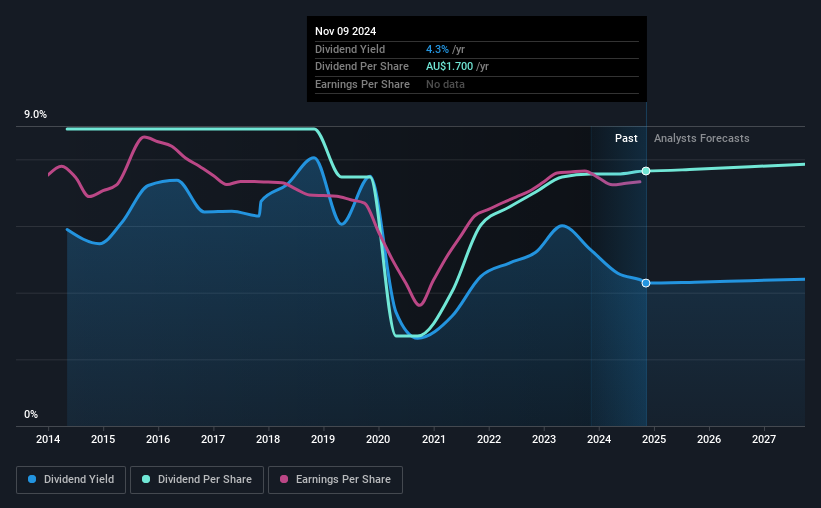National Australia Bank's (ASX:NAB) Shareholders Will Receive A Bigger Dividend Than Last Year

The board of National Australia Bank Limited (ASX:NAB) has announced that it will be paying its dividend of A$0.85 on the 16th of December, an increased payment from last year's comparable dividend. Based on this payment, the dividend yield for the company will be 4.3%, which is fairly typical for the industry.
Check out our latest analysis for National Australia Bank
National Australia Bank's Payment Expected To Have Solid Earnings Coverage
Solid dividend yields are great, but they only really help us if the payment is sustainable.
National Australia Bank has established itself as a dividend paying company with over 10 years history of distributing earnings to shareholders. Taking data from its last earnings report, calculating for the company's payout ratio shows 74%, which means that National Australia Bank would be able to pay its last dividend without pressure on the balance sheet.
Over the next 3 years, EPS is forecast to expand by 7.6%. Analysts estimate the future payout ratio will be 74% over the same time period, which is in the range that makes us comfortable with the sustainability of the dividend.

Dividend Volatility
The company's dividend history has been marked by instability, with at least one cut in the last 10 years. The dividend has gone from an annual total of A$1.98 in 2014 to the most recent total annual payment of A$1.70. Doing the maths, this is a decline of about 1.5% per year. Declining dividends isn't generally what we look for as they can indicate that the company is running into some challenges.
The Dividend's Growth Prospects Are Limited
Given that the dividend has been cut in the past, we need to check if earnings are growing and if that might lead to stronger dividends in the future. Earnings have grown at around 2.1% a year for the past five years, which isn't massive but still better than seeing them shrink. There are exceptions, but limited earnings growth and a high payout ratio can signal that a company has reached maturity. When the rate of return on reinvestment opportunities falls below a certain minimum level, companies often elect to pay a larger dividend instead. This is why many mature companies often have larger dividend yields.
Our Thoughts On National Australia Bank's Dividend
In summary, it's great to see that the company can raise the dividend and keep it in a sustainable range. The payout ratio looks good, but unfortunately the company's dividend track record isn't stellar. The payment isn't stellar, but it could make a decent addition to a dividend portfolio.
It's important to note that companies having a consistent dividend policy will generate greater investor confidence than those having an erratic one. However, there are other things to consider for investors when analysing stock performance. For example, we've picked out 1 warning sign for National Australia Bank that investors should know about before committing capital to this stock. Is National Australia Bank not quite the opportunity you were looking for? Why not check out our selection of top dividend stocks.
Valuation is complex, but we're here to simplify it.
Discover if National Australia Bank might be undervalued or overvalued with our detailed analysis, featuring fair value estimates, potential risks, dividends, insider trades, and its financial condition.
Access Free AnalysisHave feedback on this article? Concerned about the content? Get in touch with us directly. Alternatively, email editorial-team (at) simplywallst.com.
This article by Simply Wall St is general in nature. We provide commentary based on historical data and analyst forecasts only using an unbiased methodology and our articles are not intended to be financial advice. It does not constitute a recommendation to buy or sell any stock, and does not take account of your objectives, or your financial situation. We aim to bring you long-term focused analysis driven by fundamental data. Note that our analysis may not factor in the latest price-sensitive company announcements or qualitative material. Simply Wall St has no position in any stocks mentioned.
About ASX:NAB
National Australia Bank
Provides financial services to individuals and businesses in Australia, New Zealand, Europe, Asia, the United States, and internationally.
Excellent balance sheet and fair value.
Similar Companies
Market Insights
Community Narratives




